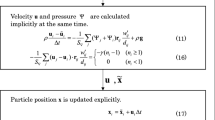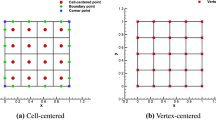Abstract
To increase the reliability of simulations by particle methods for incompressible viscous flow problems, convergence studies and improvements in accuracy are considered for a fully explicit particle method for incompressible Navier–Stokes equations. The explicit particle method is based on a penalty problem, which converges theoretically to the incompressible Navier–Stokes equations and is discretized in space by generalized approximate operators defined as a wider class of approximate operators than those of the smoothed particle hydrodynamics and moving particle semi-implicit methods. By considering an analytical derivation of the explicit particle method and truncation error estimates of the generalized approximate operators, sufficient conditions of convergence are conjectured. Under these conditions, the convergence of the explicit particle method is confirmed by numerically comparing errors between exact and approximate solutions. Moreover, by focusing on the truncation errors of the generalized approximate operators, an optimal weight function is derived by reducing the truncation errors over general particle distributions. The effectiveness of the generalized approximate operators with the optimal weight functions is confirmed using numerical results of truncation errors and driven cavity flow. As an application for flow problems with free surface effects, the explicit particle method is applied to a dam break flow.














Similar content being viewed by others
References
Ben Moussa B (2006) On the convergence of SPH method for scalar conservation laws with boundary conditions. Methods Appl Anal 13(1):29–62
Ben Moussa B, Vila J (2000) Convergence of SPH method for scalar nonlinear conservation laws. SIAM J Numer Anal 37(3):863–887
Benz W, Asphaug E (1995) Simulations of brittle solids using smooth particle hydrodynamics. Comput Phys Commun 87(1):253–265
Domínguez JM, Crespo AJ, Valdez-Balderas D, Rogers BD, Gómez-Gesteira M (2013) New multi-gpu implementation for smoothed particle hydrodynamics on heterogeneous clusters. Comput Phys Commun 184(8):1848–1860
Ghia U, Ghia KN, Shin C (1982) High-Re solutions for incompressible flow using the Navier–Stokes equations and a multigrid method. J Comput Phys 48(3):387–411
Gingold RA, Monaghan JJ (1977) Smoothed particle hydrodynamics-theory and application to non-spherical stars. Mon Not R Astron Soc 181:375–389
Hu C, Kashiwagi M (2004) A CIP-based method for numerical simulations of violent free-surface flows. J Mar Sci Technol 9(4):143–157
Imoto Y (2016) Error estimates of generalized particle methods for the Poisson and heat equations. Ph.D. thesis, Kyushu University
Imoto Y (2018) Unique solvability and stability analysis for incompressible smoothed particle hydrodynamics method. Comput Part Mech 6(2):297–309
Imoto Y (2019) Unique solvability and stability of a generalized particle method for a Poisson equation in discrete Sobolev norms. Appl Math 64(1):33–43
Imoto Y, Tagami D (2016) A truncation error estimate of the interpolants of a particle method based on the Voronoi decomposition. JSIAM Lett 8:29–32
Imoto Y, Tagami D (2017) Truncation error estimates of approximate differential operators of a particle method based on the Voronoi decomposition. JSIAM Lett 9:69–72
Khayyer A, Gotoh H (2011) Enhancement of stability and accuracy of the moving particle semi-implicit method. J Comput Phys 230(8):3093–3118
Koshizuka S, Oka Y (1996) Moving-particle semi-implicit method for fragmentation of incompressible fluid. Nucl Sci Eng 123(3):421–434
Kreiss HO, Lorenz J, Naughton M (1991) Convergence of the solutions of the compressible to the solutions of the incompressible Navier–Stokes equations. Adv Appl Math 12(2):187–214
Liu GR, Liu MB (2003) Smoothed particle hydrodynamics: a meshfree particle method. World Scientific, Singapore
Lobovskỳ L, Botia-Vera E, Castellana F, Mas-Soler J, Souto-Iglesias A (2014) Experimental investigation of dynamic pressure loads during dam break. J Fluids Struct 48:407–434
Lucy LB (1977) A numerical approach to the testing of the fission hypothesis. Astron J 82:1013–1024
Monaghan JJ (1994) Simulating free surface flows with SPH. J Comput Phys 110(2):399–406
Monaghan JJ, Lattanzio JC (1991) A simulation of the collapse and fragmentation of cooling molecular clouds. Astrophys J 375:177–189
Morris JP, Fox PJ, Zhu Y (1997) Modeling low Reynolds number incompressible flows using SPH. J Comput Phys 136(1):214–226
Murotani K, Koshizuka S, Tamai T, Shibata K, Mitsume N, Yoshimura S, Tanaka S, Hasegawa K, Nagai E, Fujisawa T (2014) Development of hierarchical domain decomposition explicit mps method and application to large-scale tsunami analysis with floating objects. J Adv Simul Sci Eng 1(1):16–35
Oochi M, Koshizuka S, Sakai M (2010) Explicit MPS algorithm for free surface flow analysis. Trans Jpn Soc Comput Eng Sci 2010:20100013
Panizzo A (2004) Physical and numerical modelling of subaerial landslide generated waves. Ph.D. thesis, Universita degli Studi di L’Aquila
Price DJ (2012) Smoothed particle hydrodynamics and magnetohydrodynamics. J Comput Phys 231(3):759–794
Raviart PA (1985) An analysis of particle methods in numerical methods in fluid dynamics (Como, 1983), vol 1127. Lecture notes mathematics. Springer, Berlin, pp 243–324
Rogers BD, Dalrymple RA, Stansby PK (2010) Simulation of caisson breakwater movement using 2-D SPH. J Hydraul Eng 48(S1):135–141
Shakibaeinia A, Jin YC (2010) A weakly compressible MPS method for modeling of open-boundary free-surface flow. Int J Numer Methods Fluids 63(10):1208–1232
Shakibaeinia A, Jin YC (2012) MPS mesh-free particle method for multiphase flows. Comput Methods Appl Mech Eng 229:13–26
Shao S, Lo EY (2003) Incompressible SPH method for simulating Newtonian and non-Newtonian flows with a free surface. Adv Water Resour. 26(7):787–800
Acknowledgements
This study was partly supported by priority project 3 for the Post-K Computer entitled “Sophisticated numerical analysis of diverse earthquake and tsunami disaster scenarios”.
Author information
Authors and Affiliations
Corresponding author
Ethics declarations
Conflict of interest
The authors declare that they have no conflict of interest.
Additional information
Publisher's Note
Springer Nature remains neutral with regard to jurisdictional claims in published maps and institutional affiliations.
This study was partly supported by priority project 3 for the Post-K Computer entitled “Sophisticated numerical analysis of diverse earthquake and tsunami disaster scenarios”
Appendices
Appendix A: Notation
First, we summarize the computational rules of the multi-index. Let \(\alpha =(\alpha _1,\alpha _2,\ldots ,\alpha _d)\) be the \(d\)th multi-index. For a vector \(x\in \mathbb {R}^d\), we denote the kth element of x as \({x}^{(k)}\). Then, that operations for the multi-index are defined by
Let \(D^\alpha \) be the differential operator defined by
where \(D^\alpha v=v\) if \(|\alpha |=0\).
Next, we introduce some functional spaces. For a set \(S\subset \mathbb {R}^d\,(d\in \mathbb {N})\), let \(C(\overline{S})\) be the space of real continuous functions defined in \(\overline{S}\), where \(\overline{S}\) is the closure of S. The norm of \(C(\overline{S})\) is defined by
For an open set S and positive integer k, let \(C^k(\overline{S})\) be the space of functions in \(C(\overline{S})\) with derivatives up to the kth order. The norm of \(C^k(\overline{S})\) is defined as
Here, \(\alpha \) is the multi-index. For a functional space \(X(\overline{S})\), let \(C([0,T];X(\overline{S}))\) be the space of functions on \(\overline{S}\times [0,T]\) satisfying
Appendix B: Derivation of generalized approximate operators
We present the derivations of the generalized approximate operators in Sect. 2.2. The derivations we will show are characterized as deriving them uniformly. Let \(x_{i}^{}\in \mathcal {X}_N\cap \Omega \). Let \(B_r(x)\) be an open ball with the center at x and radius r:
Then, by Taylor expansion, for \(y\in B_h(x_{i}^{})\setminus \{x_{i}^{}\}\) and \(v\in C^n(\overline{\Omega }_{H})~(n\in \mathbb {N})\), we have
Here, \(\alpha \) is a multi-index and \(R_{n,i}(y;\phi )\) is the residual given by
For \(k=1,2,\ldots ,d\) and nonnegative integer l, let \(\beta _{k,l}\) be a multi-index such that the kth element is l, while the others are 0. For \(n=2, 3, 4\) and \(k=1,2,\ldots ,d\), multiplying both the sides of (111) by
and integrating it over \(\Omega _{H}\), we get
Here, \(E_{i,k,n}\) is
By considering that
for (113) with \(n=2,3\), we obtain
and
Moreover, when \(n=4\), by
and
we obtain
By (4), the above integration can be approximated as
Therefore, by (116) and (121), and replacing \(w\) with \(w^{\Pi }\in \mathcal {W}\), we derive the generalized interpolant (8) as follows:
By (117) and (121), and replacing \(w\) with \(w^{\nabla }\in \mathcal {W}\), we derive the generalized approximate gradient operator (9) as follows:
Moreover, by (120) and (121), and replacing \(w\) with \(w^{\Delta }\in \mathcal {W}\), we derive the generalized approximate Laplace operator (10) as follows:
The derivations are characterized as to be able to uniformly derive the generalized approximate operators by utilizing (113). The generalized approximate operators can be used as approximate operators of the conventional particle methods such as SPH and MPS by selecting the parameters of the generalized approximate operators appropriately; this is discussed further in “Appendix C”. Therefore, approximate operators of conventional particle methods can be derived using the abovementioned method.
Appendix C: Description of approximate operators in SPH and MPS using generalized approximate operators
We show that the generalized approximate operators (8)–(10) denote approximate operators in SPH and MPS if their parameters are selected appropriately. Let \(w^\mathrm{SPH}\in \mathcal {W}\) be a reference weight function such that
where \(\dot{w}^\mathrm{SPH}\) is the first derivative of \(w^\mathrm{SPH}\). Then, in SPH, the interpolant \(\Pi _{h}^\mathrm{SPH}\), approximate gradient operator \(\nabla _{h}^\mathrm{SPH}\), and approximate Laplace operator \(\Delta _{h}^\mathrm{SPH}\) are defined as
respectively. Here, \(m_j\) and \(\rho _j\) are positive parameters referred to as the particle mass and particle density, respectively. The particle volume set \(\mathcal {V}_N\) is given by \(\mathcal {V}_N=\{V_{i}=m_{i}/\rho _{i}\mid i=1,\ldots ,N\}\). Then, from (125), the generalized interpolant (8) with \(w^{\Pi }=w^\mathrm{SPH}\) is equivalent to the interpolant of SPH (127). From
the generalized approximate gradient operator (9) with \(w^{\nabla }=-\dot{w}^\mathrm{SPH}\) is equivalent to the approximate gradient operator of SPH (128). Moreover, from (130), the generalized approximate Laplace operator (10) with
is equivalent to the approximate Laplace operator of SPH (129).
Let \(w^\mathrm{MPS}\in \mathcal {W}\) be a reference weight function defined by (74). A weight function \(w^\mathrm{MPS}_{h}\) is set by (6). Then, in MPS, the approximate gradient operator \(\nabla _{h}^\mathrm{MPS}\) and approximate Laplace operator \(\Delta _{h}^\mathrm{MPS}\) are defined as
respectively. Here, \(n_0\) and \(\lambda _0\) are parameters that depend on both \(w^\mathrm{MPS}\) and \(h\). In general, \(\lambda _0\) is given by \(\lambda _0=C_2(w^\mathrm{MPS}_{h})\). Then, the particle volume set \(\mathcal {V}_N\) is given by \(\mathcal {V}_N=\{V_{i}=C_0(w^\mathrm{MPS}_{h})/n_0\mid i=1,\ldots ,N\}\). Further, the generalized approximate gradient operator (9) with
is equivalent to the approximate gradient operator of MPS (132). Furthermore, the generalized approximate Laplace operator (10) with \(w^{\Delta }=w^\mathrm{MPS}\) is equivalent to the approximate Laplace operator of MPS (133) with \(\lambda _0=C_2(w^\mathrm{MPS}_{h})\).
Appendix D: Truncation error estimates of generalized approximate operators
We show truncation error (26) of the generalized Laplace operators using their derivations. We have established a more precise theorem to estimate truncation errors, which have been reported in the literature [8, 11, 12]. However, because the formulations of approximate operators are a little different for that in previous studies, we simplistically show the proof. We assume \(x_{i}^{}\in \mathcal {X}_N\cap \Omega \), \(\phi \in C^4(\overline{\Omega }_{H})\), and \(w^{\Delta }\in \mathcal {W}\cap C^1([0,\infty ))\). From the derivation of the generalized approximate Laplace operator (124), we estimate its truncation error as
Here,
Note that the estimate \(\widetilde{E}_{i}=\mathcal {O}(h^2)\) is derived from (114). Now, we estimate the error \(\widehat{E}_{i}\), which consists of the integration and the numerical integration, which are the first and second terms on the right-hand side of (137), respectively. For a \(C^1\) class function \(g:\Omega _{H}\rightarrow \mathbb {R}\) and generators \(y_i\in \Omega _{H}\,(i=1,2,\ldots ,N)\), we assume a numerical integration for the integration of g over \(\Omega _{H}\) given by
Here, \(\sigma =\{\sigma _i\}_{i=1}^{N}\) is a decomposition of \(\Omega _{H}\) satisfying
where \(\overline{\sigma }_i\) is the closure of \(\sigma _i\). Then, as an estimate of the Riemann sum, we can estimate the numerical integration as
Here, \(\mathrm{rad}(\sigma _i):=\sup \left\{ |y_i-z|\;\big |\;z\in \sigma _i\right\} \). Furthermore, because \(\sigma \) is arbitrary, we can estimate the numerical integration as
Let any \(\sigma =\{\sigma _i\}_{i=1}^{N}\) such that (21)–(23). Furthermore, we assume \(\delta _\infty \le h\). Then, by Taylor’s theorem, we can estimate the following:
Because \(\sigma \) is arbitrary, we obtain
Hence, \(\delta _\infty \le h\) yields
Consequently, by (135) and (136), and (144), we establish
Rights and permissions
About this article
Cite this article
Imoto, Y., Tsuzuki, S. & Nishiura, D. Convergence study and optimal weight functions of an explicit particle method for the incompressible Navier–Stokes equations. Comp. Part. Mech. 6, 671–694 (2019). https://doi.org/10.1007/s40571-019-00247-y
Received:
Revised:
Accepted:
Published:
Issue Date:
DOI: https://doi.org/10.1007/s40571-019-00247-y




